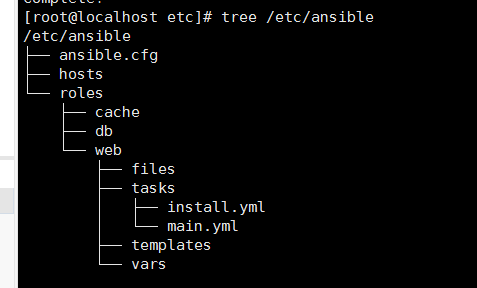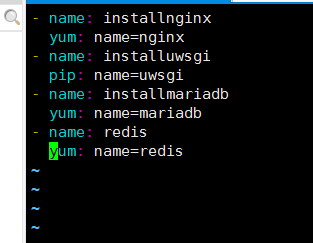setup
ansible_all_ipv4_addresses # ipv4的所有地址 ansible_all_ipv6_addresses # ipv6的所有地址 ansible_date_time # 获取到控制节点时间 ansible_default_ipv4 # 默认的ipv4地址 ansible_distribution # 系统 ansible_distribution_major_version # 系统的大版本 ansible_distribution_version # 系统的版本号 ansible_domain #系统所在的域 ansible_env #系统的环境变量 ansible_hostname #系统的主机名 ansible_fqdn #系统的全名 ansible_machine #系统的架构 ansible_memory_mb #系统的内存信息 ansible_os_family # 系统的家族 ansible_pkg_mgr # 系统的包管理工具 ansible_processor_cores #系统的cpu的核数(每颗) ansible_processor_count #系统cpu的颗数 ansible_processor_vcpus #系统cpu的总个数=cpu的颗数*CPU的核数 ansible_python # 系统上的python ansible cache -m setup -a 'filter=*processor*' # 用来搜索
正则回顾:
* 匹配数量,表示0或者多次 ? 匹配数量,表示0或者1次 . 除换行符以外的所有字符 + 至少一次 [123abc] 匹配内容,or () 分组 {m} 次数,出现m次 {m,} 至少m次 {m,n}出现m-n次 a*.b 与 a.*b # 第一个是0个或多个a +任意 +b 第二个是 a + 任意的0到多个 + b
条件判断
不同的系统
不同的版本
不同的环境
不同的用户
- hosts: db remote_user: root tasks: - name: createfile copy: content="大弦嘈嘈如急雨" dest=/tmp/a.txt when: a=="3" - name: cratefile copy: content="小弦切切如私语" dest=/tmp/a.txt when: a=="4"
Ubuntu 安装包的方式是apt-get
tags
- hosts: db tasks: - name: wadong tieqiao: wadong - name: tk dong: tk tags: tk - hosts: web tasks: - name: installnginx yum: name=nginx - name: copyfile copy: src=/etc/nginx/nginx.conf dest=/etc/nginx/nginx.conf tags: copyfile - name: start service: name=nginx state=started ansible-playbook -t copyfile p7.yml # 为任务打上标签只有标签中的任务会执行
循环 with_item
一次性创建多个
- hosts: gb tasks: - name: gbqc dong: {{ item }} with_items: - qbqc - cyf - ssfj - hosts: web tasks: - name: crateuser user: name={{item}} with_items: - alex20 - alex21 - alex22 ~ - hosts: web tasks: - name: crateuser user: name={{item}} with_items: - alex30 - alex31 - alex32 - name: crategroup group: name={{item}} with_items: - wulaoshi20 - wulaoshi21 - wulaoshi22 ~
嵌套循环
- hosts: web tasks: - name: crategroup group: name={{item}} with_items: - wulaoshi30 - wulaoshi31 - wulaoshi32 - name: createuser user: name={{item.name}} group={{item.group}} with_items: - {'name':alex40,'group':wulaoshi30} - {'name':alex41,'group':wulaoshi31} - {'name':alex42,'group':wulaoshi32}
template:
jinja2
- hosts: web tasks: - name: installredis yum: name=redis - name: copyfile template: src=/etc/redis.conf dest=/etc/redis.conf - name: start service: name=redis state=started 配置文件: bind {{ ansible_default_ipv4.address }}
copy和tamplate的区别
-
copy模块不替代参数
-
template模块替代参数
- hosts: web
tasks:
- name: installredis
yum: name=redis
- name: copyfile
template: src=redis.conf dest=/etc/redis.conf
- name: start
service: name=redis state=started
ps:写相对路径: 在当前目录下新建一个templates目录,然后把文件放在templates目录里面
handlers
不会执行handlers 下的 name 如果需要执行需要加入参数notify: name
- hosts: web tasks: - name: installredis yum: name=redis - name: copyfile template: src=redis.conf dest=/etc/redis.conf tags: copyfile notify: restart - name: start service: name=redis state=started handlers: - name: restart service: name=redis state=restarted
roles
-
目录清晰
-
可以互相调用
roles文件夹
文件夹里面是要创建的每一个角色,每一个角色一个文件夹每一个角色里面都有tasks(必须的),templates,files,handlers,vars目录,每个目录都要有main.yml文件,通过import_tasks来调用
其中templates文件夹中的文件可以通过相对路径来调用,其中files文件夹中的文件是否可以通过相对路径来调用?

创建如上文件夹,我们设置的任务文件写在tasks文件夹下
需要住的是文件夹下必须要有主文件,main.yml
install.yml文件:

web.yml文件 可以创建在任意位置 格式如下:

服务配置:
setenforce 0 #用来临时关闭selinux iptables -F # 临时关闭防火墙 /etc/selinux/config # 永久关闭